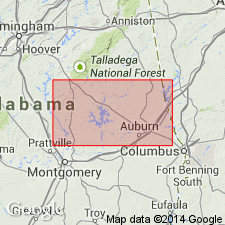
- Usage in publication:
-
- Elkahatchee Granite
- Modifications:
-
- Named
- Dominant lithology:
-
- Granite
- AAPG geologic province:
-
- Piedmont-Blue Ridge province
Summary:
Name Elkahatchee Granite of the Pinckneyville Granite complex introduced in this report. Occurs in AL and GA. No type locality stated. Age is Paleozoic.
Source: GNU records (USGS DDS-6; Reston GNULEX).
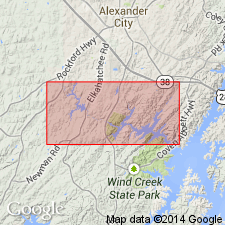
- Usage in publication:
-
- Elkahatchee quartz diorite gneiss
- Modifications:
-
- Geochronologic dating
- Age modified
- AAPG geologic province:
-
- Piedmont-Blue Ridge province
Summary:
Elkahatchee and Pinckneyville complex used informally. Type locality stated as exposures along Elkahatchee Creek in Tallapoosa Co., east-central AL. Unit described as dark gray quartz diorite gneiss older than Hissop granite. Rb-Sr (whole rock) and U-Pb (zircon) ages of 500 to 530 m.y. indicate a Late Cambrian age.
Source: GNU records (USGS DDS-6; Reston GNULEX).
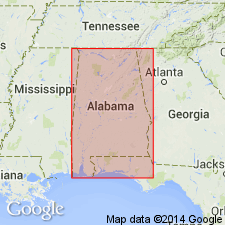
- Usage in publication:
-
- Elkahatchee Quartz Diorite
- Modifications:
-
- Geochronologic dating
- Areal extent
- AAPG geologic province:
-
- Piedmont-Blue Ridge province
Summary:
Ordovician age has been determined for the Elkahatchee. Dating of zircons yields age of 490+/-28 Ma. Unit is largest exposed body of granitic rock in AL. Extends 60 km along strike. Width varies from 10 to 20 km. Was dominant lithology of Pinckneyville Quartz Diorite of Gault (1945). Informally renamed by Deininger and others (1973).
Source: GNU records (USGS DDS-6; Reston GNULEX).
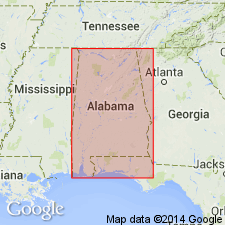
- Usage in publication:
-
- Elkahatchee Quartz Diorite Gneiss
- Modifications:
-
- Overview
- AAPG geologic province:
-
- Piedmont-Blue Ridge province
Summary:
Elkahatchee Quartz Diorite Gneiss is described as a fine- to coarse-grained, massive to strongly foliated, mesocratic to melanocratic, locally sheared granodiorite to diorite. Occurs in the northern Piedmont of AL. Pinckneyville Complex not used.
Source: GNU records (USGS DDS-6; Reston GNULEX).
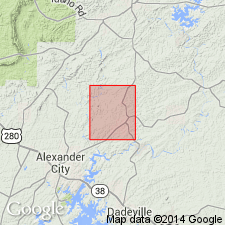
- Usage in publication:
-
- Elkahatchee Quartz Diorite Gneiss
- Modifications:
-
- Overview
- Geochronologic dating
- AAPG geologic province:
-
- Mid-Gulf Coast basin
Summary:
Unit makes up largest portion of igneous suite originally called Pinckneyville quartz diorite complex (Adams, 1926). Elkahatchee is a medium- to coarse-grained biotite tonalite gneiss. Associated with the unit are small bodies and dikes of pegmatite, granodiorite, and trondhjemite that postdate the intrusion of the main batholith. These have been previously mapped as Bluff Springs Granite. Russell and others (1987: Granites of AL, AL Geological Survey, p. 239-250) report an Rb-Sr age of 490+/-28 Ma for the Elkahatchee, indicating a minimum age of Late Cambrian to Middle Ordovician age for the Wedowee Group, which it intrudes.
Source: GNU records (USGS DDS-6; Reston GNULEX).
For more information, please contact Nancy Stamm, Geologic Names Committee Secretary.
Asterisk (*) indicates published by U.S. Geological Survey authors.
"No current usage" (†) implies that a name has been abandoned or has fallen into disuse. Former usage and, if known, replacement name given in parentheses ( ).
Slash (/) indicates name conflicts with nomenclatural guidelines (CSN, 1933; ACSN, 1961, 1970; NACSN, 1983, 2005, 2021). May be explained within brackets ([ ]).

